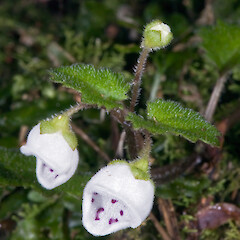Jovellana repens
Family
Calceolariaceae
Flora category
Vascular – Native
Endemic taxon
Yes
Endemic genus
No
Endemic family
No
Structural class
Herbs - Dicotyledons other than Composites
NVS code
The National Vegetation Survey (NVS) Databank is a physical archive and electronic databank containing records of over 94,000 vegetation survey plots - including data from over 19,000 permanent plots. NVS maintains a standard set of species code abbreviations that correspond to standard scientific plant names from the Ngä Tipu o Aotearoa - New Zealand Plants database.
JOVREP
Chromosome number
2n = 36
Current conservation status
The conservation status of all known New Zealand vascular plant taxa at the rank of species and below were reassessed in 2017 using the New Zealand Threat Classification System (NZTCS) – more information about this can be found on the NZTCS website. This report includes a statistical summary and brief notes on changes since 2012 and replaces all previous NZTCS lists for vascular plants.
Please note, threat classifications are often suggested by authors when publications fall between NZTCS assessment periods – an interim threat classification status has not been assessed by the NZTCS panel.
- Conservation status of New Zealand indigenous vascular plants, 2017 . 2018. Peter J. de Lange, Jeremy R. Rolfe, John W. Barkla, Shannel P. Courtney, Paul D. Champion, Leon R. Perrie, Sarah M. Beadel, Kerry A. Ford, Ilse Breitwieser, Ines Schönberger, Rowan Hindmarsh-Walls, Peter B. Heenan and Kate Ladley. Department of Conservation. Source: NZTCS and licensed by DOC for reuse under the Creative Commons Attribution 4.0 International licence.
2017 | Not Threatened
Previous conservation statuses
2012 | Not Threatened
2009 | Not Threatened
2004 | Not Threatened
Distribution
North and South Islands from Mt Pirongia (in the west) and Te Moehau (in the East) south. Mostly montane and sparse in the northern part of range but becoming more common and ranging from lowland to upper montane from about the main North Island axial ranges south.
Habitat
In shaded sites along streamsides – on banks and amongst boulders where silt, sand and humus has accumulated, also in seepages on banks, cliffs and within forest.
Detailed description
Herbaceous, ± glandular-pubescent, widely creeping, much-branched perennial forming leafy patches 1-2 metres in diameter. Stems 20-30 mm long, slender, usually dark red to pink sometimes green, prostrate, rooting freely at nodes; branches prostrate, apices weakly ascendant, ± filiform, clad in patent hairs. Leaves opposite, membranous (somewhat brittle), finely pubescent; petiole fleshy, 5-12 × 2.0-2.3 mm, clad in fine patent hairs; lamina 10-40 mm long, dark green to reddish green above, pale green or red beneath, ovate, orbicular, suborbicular to broad-oblong, apex ± rounded, obtuse to subacute, bases abruptly truncate to weakly cordate, margins coarsely and irregularly doubly crenate-dentate. Inflorescences sparse to numerous, terminal, axillary (or both), somewhat obscured by foliage, paniculate (often occurring in groupings of 2-3 near branch apices) comprising 1-5-flowered (us. 2-3 together); pedicels subfiliform, nude or bracted. Flowers 6 mm. diameter; calyx-lobes 1-2 mm long, ovate, acute or subacute. Corolla c. 5-6 mm. diameter, cut to nearly halfway into 2 ± equal deeply concave lips, white, purple-spotted. Capsule ovoid to obovoid, 6-7 mm long. Seed 0.35-0.50 mm, dark red-brown, usually asymmetrically elliptic or broadly elliptic, occasionally oblong.
Similar taxa
Readily distinguished from the much less common Jovellana sinclairii by its creeping rather shrub forming growth habit, smaller leaves, and smaller, fewer-flowered inflorescences. Sterile plants have been confused with vegetative plants of Brachyglottis sciadophila – which differs by its lianoid growth habit with long trailing, sparsely branched, flexuous woody stems, widely spaced orbicular to broad ovate-orbicular, coarsely and acutely serrated somewhat scaberulous leaves. Nevertheless when growing on the forest floor this species has a remarkable resemblance to Jovellana, though even then it rarely roots at the nodes, and though forming tangled masses is always sparsely branched. The yellow daisy flowers of Brachyglottis sciadophila clearly distinguish it from the white-flowered Jovellana repens. Jovellana repens can also be confused with Parahebe jovellanoides. However this Parahebe has orbicular, deltoid to spathulate leaves. Flowering specimens are easily distinguished by their unbranched, 1-7-flowered racemose inflorescences, and non-pouched flowers with magenta corolla ring and stripes.
Flower colours
Violet/Purple, White
Life cycle
Seeds are dispersed by wind and possibly water (Thorsen et al., 2009).
Etymology
jovellana: A man’s name
repens: From Latin repere meaning to creep, means creeping
Attribution
Fact sheet prepared by P.J. de Lange for NZPCN (1 June 2013)
References and further reading
Thorsen, M. J.; Dickinson, K. J. M.; Seddon, P. J. 2009. Seed dispersal systems in the New Zealand flora. Perspectives in Plant Ecology, Evolution and Systematics 11: 285-309
NZPCN Fact Sheet citation
Please cite as: de Lange, P.J. (Year at time of access): Jovellana repens Fact Sheet (content continuously updated). New Zealand Plant Conservation Network. https://www.nzpcn.org.nz/flora/species/jovellana-repens/ (Date website was queried)













